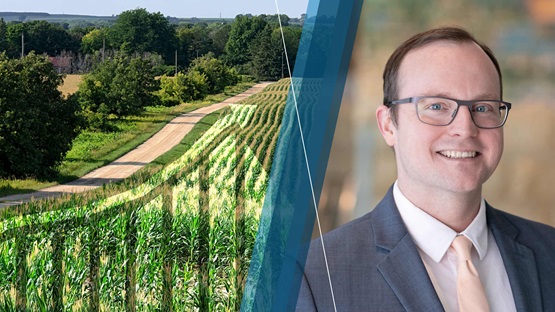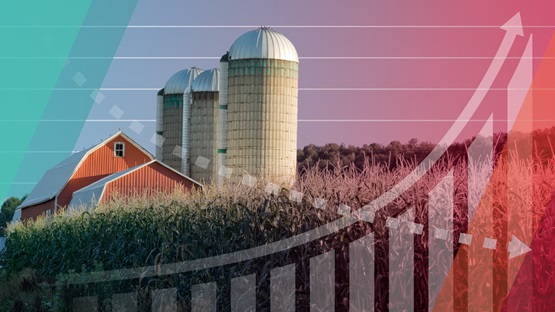Strong commodity prices continued to benefit agricultural producers in the opening months of 2023, but inflation has taken a bite, especially looking forward. “Cash flows are positive, but due to higher inputs, interest rates and family living, there is some concern,” said a Minnesota banker in a comment from a recent Federal Reserve Bank of Minneapolis survey.
According to lenders responding to the Minneapolis Fed’s first-quarter agricultural credit conditions survey, conducted in April, farm incomes and spending increased over the opening three months of 2023. Growing incomes also led to increased loan repayment rates, while loan demand decreased, and renewals and extensions also edged lower on balance. Farmland values increased on average from a year earlier across the district, and cash rents climbed as well. But the outlook for the growing season is less bullish, as respondents on balance expect declines in farm incomes and a mixed picture for spending.
Farm income, household spending, and capital investment
Half of district bankers surveyed indicated that farm incomes increased in the first quarter of 2023 compared with the first quarter of 2022 (Figure 1). By contrast, only 15 percent of respondents reported decreased incomes from a year ago. Similarly, 53 percent of lenders reported seeing an increase in household spending. Capital spending by farming operations was flatter, as 44 percent of respondents reported no change. A slightly higher share of those remaining indicated increases than those who reported decreases. Some lenders noted that due to higher interest rates, many equipment purchases were being paid for in cash rather than through loans.
Loan repayments and renewals
“Renewal season is progressing and we are seeing decent earned net worth gains for the most part,” commented a South Dakota banker. While 69 percent of lenders reported no change in the number of loan renewals or extensions, 22 percent said renewal activity decreased. The rate of repayment on agricultural loans increased, according to 40 percent of respondents. Most of the remainder reported that repayment rates were unchanged.
Demand for loans, required collateral, and interest rates
Given improved income for farmers, loan demand fell. Nearly half of bankers in the survey reported a lower loan demand in the first quarter relative to the same period a year earlier, compared with 13 percent who noted increased loan demand. The amount of required collateral saw no change at 92 percent of agricultural banks. Interest rates on farm loans continued to increase, following a year-long trend. Average fixed and variable rates on operating, machinery, and real estate loans each increased in the first quarter by at least 25 basis points or more from the end of 2022.
Cash rents and land values
The growth in land values seen over the past several years continued but tapered off, and cash rents also grew. Ninth District nonirrigated cropland values increased by more than 11 percent on average from the first quarter of 2022, though compared with the most recent quarter they actually fell slightly. Irrigated cropland values also rose, by 10 percent from a year ago, while ranchland and pastureland values edged up 3 percent. The district average cash rent for nonirrigated land rose by almost 8 percent from a year ago. Rents for irrigated land increased 10 percent, while ranchland rents increased 7 percent. Changes in land values and rents were generally consistent across district states.
Outlook
Expectations heading into the growing season are somewhat cautious. Across the district, 48 percent of lenders predicted that farm income will decrease in the second quarter from the same period in 2022, compared with 17 percent forecasting increases. The outlook for capital spending is also down on balance, with 38 percent expecting declines, while a third of respondents expect farm household spending to increase. Expectations call for an uptick in borrowing in the upcoming quarter—37 percent think loan demand will increase, compared with 21 percent who think it will fall. The outlook for loan repayment is positive on balance, though two-thirds expect no change in repayment rates. Survey respondents overwhelmingly indicated they expect no change in renewals and extensions to decrease on balance. Nearly all anticipate no change in required collateral, though 10 percent expect collateral requirements to increase.
An additional question on the first-quarter survey asked lenders about their biggest concerns for agriculture this year. By a large margin, commodity price volatility is the most common concern, selected by 52 percent of respondents. Rising interest rates, at 27 percent, is next, followed by input cost and/or availability (Figure 2).
Heavy winter snowfall presented a mixed bag, according to comments. In some areas heavily affected by drought last year, the added moisture was an encouraging start to the year. In other areas, lenders are concerned about a delayed spring. “More snow on the ground now than we have seen in several years,” reported a banker in the Red River Valley. “Looking to be an extremely late plant.”
| MN | MT | ND | SD | WI | Ninth District | |
|---|---|---|---|---|---|---|
| Percent of respondents who reported decreased levels for the past three months compared with the same period last year: | ||||||
| Rate of loan repayments | 5 | – | 9 | – | – | 4 |
| Net farm income | 9 | – | 36 | 13 | – | 15 |
| Farm household spending | – | – | 9 | 13 | – | 6 |
| Farm capital spending | 18 | – | 45 | 29 | – | 26 |
| Loan demand | 55 | – | 45 | 47 | – | 46 |
| Percent of respondents who reported increased levels for the past three months compared with the same period last year: | ||||||
| Loan renewals or extensions | 5 | – | 27 | – | 33 | 10 |
| Referrals to other lenders | – | – | – | – | – | – |
| Amount of collateral required | – | – | 18 | 13 | – | 8 |
| Loan demand | 14 | – | 18 | 7 | 33 | 37 |
| MN | MT | ND | SD | WI | Ninth District | |
|---|---|---|---|---|---|---|
| Percent of respondents who expect decreased levels for the next three months: | ||||||
| Rate of loan repayments | 18 | – | 9 | 7 | – | 12 |
| Net farm income | 55 | – | 55 | 40 | 33 | 48 |
| Farm household spending | 9 | – | 9 | 13 | 33 | 12 |
| Farm capital spending | 41 | – | 45 | 33 | 33 | 38 |
| Loan demand | 14 | – | 36 | 27 | – | 21 |
| Percent of respondents who expect increased levels for the next three months: | ||||||
| Loan renewals or extensions | – | – | 18 | 7 | 33 | 8 |
| Referrals to other lenders | – | – | – | – | – | – |
| Amount of collateral required | 5 | – | 18 | 13 | – | 10 |
| Loan demand | 36 | – | 36 | 33 | 67 | 37 |
| Operating | Machinery | Real estate | |||||
|---|---|---|---|---|---|---|---|
| Fixed | Var. | Fixed | Var. | Fixed | Var. | ||
| Q2-21 | July | 4.7 | 4.5 | 4.5 | 4.4 | 4.3 | 4.1 |
| Q3-21 | October | 4.6 | 4.5 | 4.4 | 4.3 | 4.2 | 4.1 |
| Q4-21 | January | 4.7 | 4.4 | 4.5 | 4.3 | 4.3 | 4.1 |
| Q1-22 | April | 4.7 | 4.6 | 4.7 | 4.5 | 4.5 | 4.3 |
| Q2-22 | July | 5.5 | 5.4 | 5.5 | 5.3 | 5.4 | 5.1 |
| Q3-22 | October | 6.5 | 6.3 | 6.2 | 6.1 | 5.9 | 5.8 |
| Q4-22 | January | 7.7 | 7.6 | 7.3 | 7.3 | 7.0 | 7.0 |
| Q1-23 | April | 8.1 | 8.0 | 7.6 | 7.6 | 7.3 | 7.4 |
Joe Mahon is a Minneapolis Fed regional outreach director. Joe’s primary responsibilities involve tracking several sectors of the Ninth District economy, including agriculture, manufacturing, energy, and mining.





